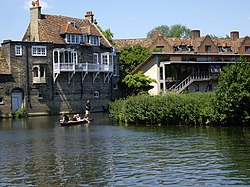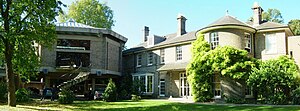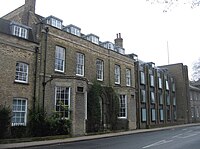Difference between revisions of "Darwin College, Cambridge"
(Created page with "{{Infobox college |name=Darwin College |county=Cambridgeshire |university=Cambridge |city=Cambridge |livery=A3C1AD |headtext=black |arms=Darwin College Arms.svg |picture=Darwi...") |
(No difference)
|
Latest revision as of 21:36, 31 March 2024
| Darwin College
| |||||||||||||||||||
 Darwin College's buildings from the River Cam | |||||||||||||||||||
|---|---|---|---|---|---|---|---|---|---|---|---|---|---|---|---|---|---|---|---|
| Master: | Mike Rands | ||||||||||||||||||
| Website: | darwin.cam.ac.uk | ||||||||||||||||||
| |||||||||||||||||||
| Location | |||||||||||||||||||
| Grid reference: | TL44555792 | ||||||||||||||||||
| Location: | 52°12’2"N, 0°6’49"E | ||||||||||||||||||
Darwin College is a constituent college of the University of Cambridge. Founded on 28 July 1964, Darwin was Cambridge University's first graduate-only college, and also the first to admit both men and women. The college is named after one of the university's most famous families and alumni, from which came Charles Darwin. The Darwin family previously owned some of the land, Newnham Grange, on which the college now stands.
The college has between 650 and 800 students, mostly studying for PhD or MPhil degrees with strengths in the sciences, humanities, and law. About half the students come from outside the United Kingdom, representing 80 nationalities as of 2016. Darwin is the largest graduate college of Cambridge.
Members of Darwin College are termed Darwinians. The college has several distinguished alumni including prominent heads of government and state, politicians, diplomats, and scientists from various countries.
Contents
History
A significant increase in the number of postgraduate students at Cambridge University in the post-war period led to a growing realisation that a graduate college was becoming a necessity. In 1963, three of the university's older colleges – Trinity College, St John's College, and Gonville and Caius College – announced their intention to jointly form a new, wholly graduate college. The college was established in 1964, located on the bank of the River Cam, opposite Queens' College. On 29 January 1965, the Privy Council gave formal approval to the college as an Approved Foundation. It received its Royal Charter as an independent college within the university in 1976.
The college is named after the Darwin family: Charles Darwin's second son, George Darwin, owned some of the property which the college now occupies. He bought Newnham Grange, the oldest part of the college, in 1885, together with the adjacent building known as The Old Granary, and Small Island. (Newnham Grange was originally built in 1793 for the family of Patrick Beales, a local corn and coal merchant. It was extensively remodelled by George Darwin.)
Following the death of George's son, Sir Charles Galton Darwin, in 1962, those concerned with the foundation of the new college learned that the property was to become available. Katherine, Lady Darwin, and her family were very receptive to the idea of their home becoming the nucleus of a new college, and to the suggestion that it should bear the family's name. Family portraits of the Darwin family are on loan to the college from the Darwin Heirloom Trust and can be found on the walls of several of the college's main rooms. In the book Period Piece: A Cambridge Childhood, the granddaughter of Charles Darwin, Gwen Raverat describes how she grew up at Newnham Grange.[1][citation needed]
A commemorative book entitled Darwin College: A 50th Anniversary Portrait was commissioned and published by the college in 2014 to commemorate the 50th anniversary of the founding of the college in 1964.[2]
Buildings
Darwin College is known for its distinctive Georgian and Victorian architecture, gardens, and college site which is integrated into the nearby River Cam.
Located on Silver Street and Newnham Road, the college is also known for the Darwin College Bridges which connect the college grounds with the two islands of the college.
In 1966 the college acquired the Hermitage (a house built in the nineteenth century on the west side of Newnham Grange) from St John's College. Work to convert and extend the college's buildings was funded by the founding colleges and through substantial donations from the Rayne Foundation established by Sir Max Rayne, a businessman and philanthropist.
In 1994 Darwin College completed construction of a new library and study centre along the side of The Old Granary. The centre is built on a narrow strip of land alongside the millpond in Cambridge, and uses a structure of green oak and lime mortar brickwork. The building uses high-level automatically opening windows and a chimney to control natural ventilation.
In 2004, the college acquired the Malting House to accommodate 12 students. The Malting House is Grade II listed and its name reflects the original purpose of the building. The building was the home of the Malting House School, which experimented with radical ideas in education in the 1920s.
In 2010 the college acquired No 4 Newnham Terrace, the former Rectory for the Church of St Mary the Less, Cambridge (Little St Mary's) thereby finally establishing an entire boundary for the college from Queen's Bridge to Newnham Road and to the River Granta. The long boundary returns to Queen's Bridge and is formed by the two islands in the middle of the river.
Outside links
| ("Wikimedia Commons" has material about Darwin College, Cambridge) |
References
- ↑ Raverat, Gwendolen Mary (1952). Period Piece. W. W. Norton, Inc..
- ↑ "A 50th Anniversary Portrait | Darwin College Shop". https://shop.dar.cam.ac.uk/darwinbooks/50th-anniversary-portrait/.



